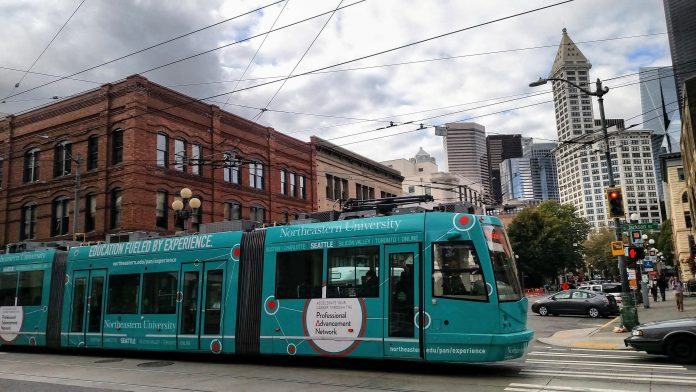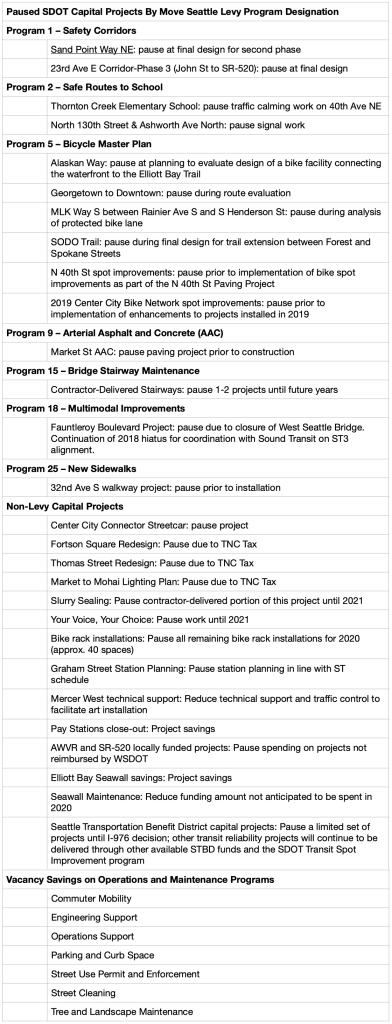
On Wednesday, the Seattle Department of Transportation (SDOT) announced a series of “paused” transportation projects to respond to the economic fallout from the Covid epidemic. The delayed projects cover many corners of the city and some parts of the transportation budget, including six Bicycle Master Plan projects, the perennially besieged Center City Connector Streetcar, and the long-promised pedestrian-focused green street on Thomas Street. Director Sam Zimbabwe called the cuts “thoughtful, but immediate action.” The cost savings from stopping the projects is $58.3 million or 8% of SDOT’s $739 million adopted budget.

In his message accompanying the list of cuts, Director Zimbabwe said the pauses allow for SDOT to “understand our fiscal constraints, identify immediate cost savings to address budget shortfalls, and establish a thoughtful, equity-first process for 2021 and beyond.”
The department highlighted projects that will continue, many of which are in advanced stages of construction. Automobile bridges like the Lander Street Overpass and Fairview Bridge Replacement, bike facilities on MLK Way north of Rainier and from Georgetown to South Park, and Rapid RideH Line in Delridge and RapidRide G Line in Madison will all continue, as is construction of the Northgate Bike and Pedestrian Bridge.
A number of holds are on projects that were moving ahead of their projected need. Planning for Sound Transit 3 (ST3) at Graham Street is paused to move in line with the Sound Transit schedule for the station’s opening in 2031. This comes after the community’s push to get the infill station on ST3. The West Seattle Bridge repair or replacement will itself continue, whatever form that may take. However, the dependent Fauntleroy Boulevard Project that was already paused for ST3 will continue to be delayed until the West Seattle Bridge is sorted out.
A group of “paused” projects are reliant on funding from other sources. Seattle was supposed to bring in $8.9 million in 2020 from the new ridehailing tax. Numbers have not been released on how Covid is impacting this 57 cent tax on every Lyft and Uber trip, but the companies are not faring well and Heidi Groover has reported revenues are expected to be half of expected. Projects based on that tax have been paused, including lighting from Pike Place Market to MOHAI, and redesigned street projects on Fortson Square and Thomas Street–which was a signature bike and pedestrian upgrade meant to accompany the SR-99 tunnel and new Seattle Center Arena.
While the text of Director Zimbabwe’s message emphasizes the pedestrian and transit projects that will continue, it belies the underlying preference for automobiles that are written into the SDOT budget to begin with. The value of the Lander Street overpass exceeds the entire 2020 Levy to Move Seattle budget. The 3,900 miles of street lanes in the city cost $61 million per year in maintenance and another $38 million goes to bridges and structures. Everything else–sidewalks, signs, bike paths, and trails–costs about $7 million in maintenance. Pardon if four more miles of Open Streets seems small. It is also unclear what the impact of “vacancy savings” will be on divisions like Street Use Permit and Inspections when neighborhoods and Councilmembers are fighting to open right-of-way to restaurants and retail uses.

More than a quarter of the 2020 Move Seattle Levy funds, $38 million of $141 million, is just maintaining Arterial Roadways. All of those projects will continue except the NW Market Street repaving, which some community members were asking to be put on hold. The second largest part of the levy budget, $12.1 million in 2020, is multimodal improvements. These fall under Congestion Relief, and involve improving bus transit within a network of free flowing automobiles.
Even in third place at 10% of the Levy budget, bike lanes get the longest list of cuts. Six Bicycle Master Plan projects are paused: two spot repairs and four projects paused in planning phases. The balance through the city is not very equitable–the Alaskan Way project is in Downtown (promised as part of the $4 billion viaduct replacement project) and the other three–MLK, Georgetown, and SODO–are in South Seattle. Together they total seven miles of bike lanes, which exceeds the number of bike lanes that have been built in any year of the Move Seattle Levy.
Like many SDOT projects, bike lanes are almost never just bike lanes. Many involve repairs to automobile road surfaces and signalization to merely accommodate the bicycles in car space. Infrastructure like the Northgate Pedestrian Bridge is literally just separating the problem of pedestrians from the highway instead of reconsidering the existence of such an impassible barrier.

For projects not based on the Move Seattle Levy, the headline “pause” is the Center City Connector Streetcar. Re-approved by the City Council for a $9 million design budget after a long hiatus, the project to connect the city’s two existing streetcar lines through downtown was just getting restarted and targeted a 2026 opening. Given the Durkan administration’s delays and antagonism towards the streetcar, it appears that Covid is a convenient excuse to kill the project, and long-time streetcar critic Councilmember Lisa Herbold said her intent was not a pause but to kill the project during Budget Committee on Wednesday.
Such blatant project carnage seems like a silly thing to do because people are paying attention to how cities are spending their cash. The SDOT budget cuts are occurring under a magnifying glass of #DefundThePolice, the national movement to reorganize city budgets away from militarized policing and towards preventative social programs in overpoliced communities of color. The $58.3 million in cuts to the Department of Transportation is triple the $20 million that Mayor Durkan has proposed for cutting the police budget. It represents approximately double the portion SDOT’s budget compared with SPD. This upside-down calculation was immediately noticed.
While it does not get the headlines about reducing the need for policing that housing and health care does, our transportation choices create or exacerbate many of the problems that current social movements are trying to address. Interstate 5 and Interstate 90 plowed through many of Seattle’s minority neighborhoods and has pumped carcinogenic smog onto those that remain.
Our streets are the boundaries that set apart neighborhoods to enshrine racist housing policies in loan applications and zoning. The budgets for local, state, and federal departments of transportation are steeped in the same biases that supersized police budgets. If you need any starker look at the close ties between militarized policing and our transportation choices, watch again as police use bicycles and horses and cars as battering rams, or a kid pulls an AR-15 out of the back of a police SUV, or SWAT emblazoned surplus war machines pull around the corner.
So it causes a double-take when Director Zimbabwe uses a message about cutting transportation budgets to drop a line like: “Because the financial situation of SDOT and the City continues to evolve, over the next few months we will develop criteria to guide decision-making around what work will be paused indefinitely and what will continue. As noted earlier, we will prioritize racial and social justice in our transportation system when we develop this criteria.” The pauses and cuts that were listed today are the same austerity drivel that made the 2008 recession so painful. The budget cuts skim the fluffy edges off the millions of dollars we spend to maintain the dominance of automobiles. Bikes, busses, and walking get the meat taken out of their sandwich while cars get the crust neatly trimmed off their bread.
At the same time, there is no motion from the Mayor’s Office to meet these cuts with increases in revenue. The City Council currently has two revenue bills in the works, either of which reduce the potential cuts we’re seeing in this SDOT pause. While the legislative branch is working on structural change, the executive departments are putting on a performative veneer of racial and social justice.
A limited transportation system can do real damage to a fair and equitable city by strangling it. How are we to expect the city’s transportation decision making to prioritize racial and social justice when so much of the budget is off limits? These cuts show that our city, its budget, and its transportation system are all coasting on the same four rubber tires that it has for the last half century. Those will not drive us towards real structural changes that weeks of community protests have demanded.
Ray Dubicki is a stay-at-home dad and parent-on-call for taking care of general school and neighborhood tasks around Ballard. This lets him see how urbanism works (or doesn’t) during the hours most people are locked in their office. He is an attorney and urbanist by training, with soup-to-nuts planning experience from code enforcement to university development to writing zoning ordinances. He enjoys using PowerPoint, but only because it’s no longer a weekly obligation.




